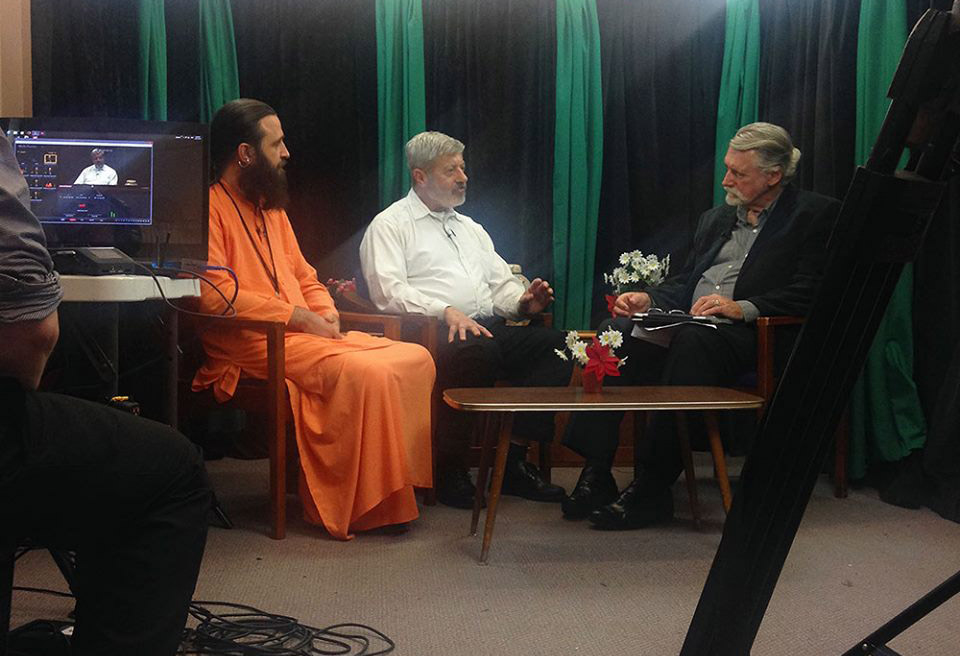It seems to me that between such a Vedic or Vedantic principle as नेति नेति (neti-neti – «neither this nor that») has much in common with द्वैताद्वैत विलक्षण (dvaitādvaita vilakṣaṇa) in the Nātha Tradition. The second is often found in the Sanskrit texts of Nāthas. In the later Nātha text in Hindi, Gorakh Sabadi, this principle is represented as अलख (alakh) – from the Sanskrit अलक्ष अ-लक्ष (a-lakṣa, i.e. «transcendence beyond the limits of symbols»).
Tag Archives: yoga
Śarabha from the yogic and tantric perspective
The name of Śarabha is first mentioned in the Rig Veda, in the hymn to Indra and Vāyu, he is mentioned as a relative of ṛṣi (शरभाय ऋषि बन्धवे śarabhāya ṛṣi bandhave):
विश्वेत्ता ते सवनेषु प्रवाच्या या चकर्थ मघवन्निन्द्र सुन्वते ।
पारावतं यत्पुरुसम्भृतं वस्वपावृणोः शरभाय ऋषिबन्धवे ॥६॥
viśvettā te savaneṣu pravācyā yā cakartha maghavannindra sunvate ।
pārāvataṃ yatpurusambhṛtaṃ vasvapāvṛṇoḥ śarabhāya ṛṣibandhave ॥ 6 ॥
Oh, Meghavan (the name of Indra, who was crowned on Mount Mekhvan)! All your actions, which grant the well-being to Pārāvana and gathered in large numbers for Śarabha, who is a relative of ṛṣi, are worthy of praise at performing sacrifices.
Besides the mention, also, in the Atharva Veda, an interesting reference of Śarabha is found in Śatapatha-brahmana, where he is mentioned as kimpuruṣa (a half-human, a half-animal):
स यं पुरुषमालभन्त । स किम्पुरुषोऽभवद्यावश्वं च गां च तौ गौरश्च गवयश्चाभवतां यमविमालभन्त स उष्ट्रोऽभवद्यमजमालभन्त स शरभोऽभवत्तस्मादेतेषां पशूनां नाशितव्यमपक्रान्तमेधा हैते पशवः – १.२.३.[९]
sa yaṃ puruṣamālabhanta। sa kimpuruṣo’bhavadyāvaśvaṃ ca gāṃ ca tau gauraśca gavayaścābhavatāṃ yamavimālabhanta sa uṣṭro’bhavadyamajamālabhanta sa śarabho’bhavattasmādeteṣāṃ paśūnāṃ nāśitavyamapakrāntamedhā haite paśavaḥ – 1.2.3.[9]
He is the person whom they offered as a sacrifice, he became kimpuruṣa; the horse and the bull, which they sacrificed, became a female and a male buffalo, and the sheep that was killed became a camel, the killed goat became Śarabha. These animals cannot be eaten, because they are devoid of sacrificial essence. 1.2.3.[9]
Later, Śarabha, also known as Śalabha, is also found in the following Purāṇas (Śriīmadbhāgavata, Matsya, Skanda, Harivamśa, Śiva and Padma Purāṇas), as well as in the Mahābhārata (Vana Parva, Śanti Parva, Adi Parva, Udyoga Parva, Droṇa Parva), in the Rāmāyaṇa (in Yuddhakanda) and also in various forms in the most diverse Tantras. Often he is described as a Deity having four paws, which symbolise the eight forms of Śiva, his thighs symbolise the vyādhi (illnesses) and mṛityu (death) that he controls. His stomach is Vadavagni Bhairava, Bālātripurasundari is in his heart, in the two wings there are the Goddesses –Śulini Durgā and Pratyaṅgirā, in the throat there is Mahakala Bhairava, in his eyes – the sun, the moon and fire, in his claws there are vajras of Indra. He also has the face of a lion.
Basically, Śarabha is known to many upāsakas as a form of Bhairava, who prevented the contamination with the blood, that Narasiṃha had drunk, killing the demon Hiraṇyakaśipu. The story is that Hiraṇyakaśipu performed austerities in order to gain the strength not to be killed either on earth or in the air, in the room or on the street, by animals or by men. Then Viṣṇu appeared in the guise of a half-lion, half-man. It happened on the steps of a palace (neither in the house nor on the street), he raised Hiraṇyakaśipu and killed him on his own knee (neither on earth nor in the air). However, after drinking the blood of Hiraṇyakaśipu, Narasiṃha began to fall under his demonic influence. For that purpose Śiva took the form of Śarabheśvara, raised Narasiṃha above the earth and “dropped” him so that he spewed all the blood of Hiraṇyakaśipu out of himself. Sometimes Śarabheśvara is called Aśu Garuḍa because he has the ability to fly. In that sense, Śarabha symbolises the strength of a large number of living beings. A modern example might be given: when new types of weapons are being developed, with more sophisticated program control and functional capabilities. In fact, Śarabha is a kind of Deity with Narasiṃha‘s “improved” abilities, more advanced to combat demons, with more flexible methods of warfare.
His name Śalabha, which translates as “grasshopper”, means that the insect is capable of making jumps that resemble a flight, although in general it is on the ground. In honour of him, there is a well-known śalabhāsana in yoga, which is quite powerful; Śalabha or Śarabha is a symbol of strength, he is full of Śakti (energy). Narayanasvami gives a yogic interpretation of the image of Śarabha in his text Tantrika Mahākāvya, for example, that his eight paws mean aṣṭāṅga-yoga, four of them look upwards (antaraṅga-yoga) and four – down (bahiraṅga–yoga). However, it seems to me, Śarabha can rather be associated with different kinds of living beings and their forces, as many yoga texts say, there are as many yogic āsanas as living beings. Mastering of āsanas could mean even more than the ability to take different positions of the body, but also probably the awareness of the various vibrational characteristics that fill the entire universe, to realise the main ability – to become a siddha-puruṣa and get out of the influence of saṃsāra and māyā. Śarabha is a Deity who removes a magical enchantment, takes the practitioner out of bewitchment by an illusory force. Therefore, he is able to grant spiritual liberation. However, the Deity includes a conglomerate of very different energies, so he is capable of giving a strong transformation, thus sādhaka should have strong self-control and be mature. Tremendous devotion to a real Guru (realised Siddha), who has realised this Deity and its mantras in himself and can transmit it in its full state to his own śiśya is a necessary part. Otherwise, mantras of Śarabha, Pratyaṅgirā, and others can greatly damage the experimenter with such mantras and sādhanas. In connection with that, I won’t make any technical information on the practice of such Deities publicly available.
Returning to the theme of yoga, a very interesting description of śarabhāsana is found in the Agama-rahasya-tantra, where many āsanas are described by the same names as in the texts of haṭha-yoga (as understood by many now). However, these āsanas are often described as mats made of different materials, on which one must sit and chant a mantra a certain number of times, which leads to different siddhis. For example, mayūrāsana, siṁhāsana, kukkuṭāsana, etc. are different materials from animal skin. But speaking of śarabhāsana, confusion may arise, because there is no such “animal” in the real nature. Respectively, the conclusion is: āsanas also mean the image itself, which carries this or that kind of force.
The uselessness of practices without a realised master
Not so long ago I was asked, “Why there are such ślokas in the last chapter (VI) of Siddha-siddhānta-paddhati:
लिङ्गाद्दण्डाङ्कुरान्तर्मनः पवनगमात् ब्रह्मनाड्यादिभेदम्।
कृत्वा बिन्दुं नयन्तः परमपदगुहां शङ्खगर्भोदरोर्ध्वम्॥
तत्रान्तर्नादघोषं गगनगुणमयं वज्रदण्डोक्रमेण।
ये कुर्वन्तीहकष्टान् परमपदमहो नास्ति तेषां निरुत्थम्॥ ७९॥
liṅgāddaṇḍāṅkurāntarmanaḥ pavanagamāt brahmanāḍyādibhedam |
kṛtvā binduṁ nayantaḥ paramapadaguhāṁ śaṅkhagarbhodarordhvam ||
tatrāntarnādaghoṣaṁ gaganaguṇamayaṁ vajradaṇḍokrameṇa |
ye kurvantīhakaṣṭān paramapadamaho nāsti teṣāṁ niruttham || 79 ||
Those who enter the brahma-nāḍi into the spine through the convergence of the mind and breathing, enter bindu into the upper state cavity through the vajroli-kriyā which is located above the cavity of the shell, and listen to a vibration similar to the sound of the heavens. They who suffer here [for the sake of perfection], do not reach the highest state of non-manifestation.
सम्यक् चालनदोहनेन सततं दीर्धीकृतां लम्बिकां।
तां ताल्वन्तखेशितां च दशमद्वारोदरे शंखिनीम्॥
नीत्वा मध्यमसन्धिसंघटघटात् प्राप्तां शिरोदेशतः।
पीत्वा षड्विधपानकाष्ठभजनं वाञ्च्छन्ति ये मोहिताः॥ ८१॥
samyak cālanadohanena satataṁ dīrdhīkṛtāṁ lambikāṁ |
tāṁ tālvantakheśitāṁ ca daśamadvārodare śaṃkhinīm||
nītvā madhyamasandhisaṁghaṭaghaṭāt prāptāṁ śirodeśataḥ |
pītvā ṣaḍvidhapānakāṣṭhabhajanaṁ vāñcchanti ye mohitāḥ || 81 ||
Those who perfectly “milk” (stretching) their tongue, as well as moving it (cālana) wrapping it back into the palatine region and through the shankhini channel in the tenth hole (brahmarandhra). Who tastes the six-part nectar from the head region.They fall into misguided path.
There’s also a lot of criticism of those who do yoga exercises. Then the question arises, how can yogic Tradition criticise methods that themselves relate to it? After criticising all these methods and yogic states, even after revealing which the yogi can fall into delusion, the following is said:
आज्ञासिद्धिकरं सदा समुचितं सम्पूर्णमाभासकं
पिण्डे सर्वगतं विधानममलं सिद्धान्तसारं वरम्।
भ्रान्तेर्निर्हरणं सुखातिसुखदं कालान्तकं शाश्वतं
तन्नित्यं कलनोज्झितं गुरुमयं ज्ञेयं निरुत्थं पदम्॥ ९३॥
ājñāsiddhikaraṁ sadā samucitaṁ sampūrṇamābhāsakaṁ
piṇḍe sarvagataṁ vidhānamamalaṁ siddhāntasāraṁ varam |
bhrānternirharaṇaṁ sukhātisukhadaṁ kālāntakaṁ śāśvataṁ
tannityaṁ kalanojjhitaṁ gurumayaṁ jñeyaṁ nirutthaṁ padam || 93 ||
The non-manifestation state is comprehended as having a nature of the Guru, it is devoid of manifestation, eternally, it destroys time, bestows supreme happiness, eliminates delusion. It, residing in the body, totally shining, granting the perfection of Will (ājña), is the pure essence of the teachings of the perfect.
The sense is that without patronage and correction from the traditional Guru realised in the purity, any practices and even “achievements” can be meaningless. These ślokas are very relevant for the present time, when yoga has lost its traditional goals.
Even if someone is not pleased to read these parts of the text, one must admit the fact that they have truth. Although the described yogic techniques being applied in the original yoga guidelines, in any case, have their value. It’s just like if an ignorant jungle man was shown a computer and the Internet, not guarantee he wouldn’t decide to dig a hole by the laptop. He has to understand what the true purpose of this device is, what its usefulness, if he learns to use it. Similarly, with any yoga methods.
What does it mean to be beyond duality and non-duality according to the Nātha doctrine?
Haṭhayogapradīpikā says:
अन्तर्लक्ष्यविलीनचित्तपवनो योगी यदा वर्तते
दृष्ट्या निश्चलतारया बहिरधः पश्यन्नपश्यन्नपि ।
मुद्रेयं खलु शाम्भवी भवति सा लब्धा प्रसादाद्गुरोः
शून्याशून्यविलक्षणं स्फुरति तत्तत्त्वं पदं शाम्भवम् ॥ ३७ ॥
antarlakṣyavilīnacittapavano yogī yadā vartate
dṛṣṭyā niścalatārayā bahiradhaḥ paśyannapaśyannapi |
mudreyaṁ khalu śāmbhavī bhavati sā labdhā prasādādguroḥ
śūnyāśūnyavilakṣaṇaṁ sphurati tattattvaṁ padaṁ śāmbhavam || 37 ||
By the grace of the Guru, when the consciousness and energy of Yogī are absorbed by the inner aim, perception (vision) is directed to the outside and motionless, but at the same time, suspended from vision; this mudrā known as śāmbhavī. That radiant essence beyond (vilakṣaṇam) of emptiness (śūnya) or fullness (aśūnya), is known as the Śambhū state (Śiva or the embodiment of appeasement).
Thuse, according to the Nātha Yogīs doctrine, to be beyond emptiness or fullness – means to be both emptiness and fullness simultaneously.








